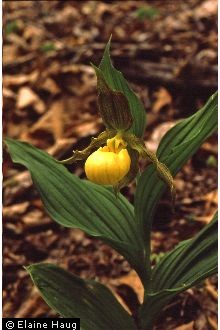Nutrition
The nutrition of C. parviflorum is very typical to the autotroph community as well as the orchid community. Because Yellow Ladyslipper Orchid is an autotroph, it produces its own nutrients via photosynthesis and does not rely on other organisms (with the exception of the early stages in the lifecycle). In the earlier stages of the life cycle, the plant relies on a fungus to bring nutrients to the rhizomes, which is the largest challenge for this organism, and the reason germination takes such a long period of time.
Good nutrition from the soil is vital to the plant for rhizome branching, root growth, disease resistance and of course, lots of flowering. However, orchids have adapted to survive on little to no nutrients, so some Yellow Ladyslipper Orchids will die when they receive too many nutrients from fertilizers. Three of the most important nutrients plants will absorb from the soil are nitrogen, phosphorus and potassium. Other nutrients that are essential in smaller amounts include: sulfur, calcium, magnesium, iron, boron, copper and zinc. These nutrients are utilized in the plant for functions like cell growth, biochemical reactions, osmosis and protein synthesis to name a few.
Early Life Cycle Nutrition:
When C. parviflorum is in the seed stage of its life cycle, it is unable to provide its own nutrients. The seed of this orchid is designed to travel great distances and then settle into a symbiotic relationship with a mycorrhizal fungus to establish itself. When the seed germinates, it will grow rhizomes off of the few nutrients it has. In turn, the rhizomes will enter a mutualistic relationship with a mycorrhizal fungus. The fungus will bring nutrients to the plant before it is able to photosynthesize (about one to four years) from either decaying material or live trees (via an ectomycorrhizal relationship) in the surrounding area, depending on which fungus is in the relationship with the orchid.
Adult Stage Nutrition:
After one to four years as the plant begins to gain foliage above the substrate, the plant will begin to acquire the majority of its energy via photosynthesis. As the amount of foliage increases, the dependency of the plant on its mutualistic relationship will decrease, if not stop all together. The formation of true roots will increase the ability of the plant to acquire the needed soil nutrients and water. As the plant grows in size, the development of xylem and phloem is displayed. Xylem is a tube structure used to transport water and soil nutrients up the plant to the photosynthetic areas. Phloem is used to transport sugars and photosynthetic byproducts down the plant to the roots. To learn more about photosynthesis, click here!
Challenges to Nutrition:
One of the main challenges to nutrition is that beginning stage of life. It is very site specific to begin the life of the plant, and because of this C. parviflorum can remain dormant for up to 8 years until the correct soil conditions are met.
Another challenge for C. parviflorum is the affinity aphids have for the phloem of this plant.
The last major challenge that C. parviflorum experiences is the over nutrition that avid gardeners will bestow upon the plant. Over fertilization creates a high salt concentration in the soil that will literally suck water out of the plant, killing it. However, many gardeners think that the more the merrier, which is not true. The adaptation orchids have to survive on less nutrition makes this plant a tricky one to cultivate, but worth it. To get some handy tips on cultivation, visit my Facts page!

